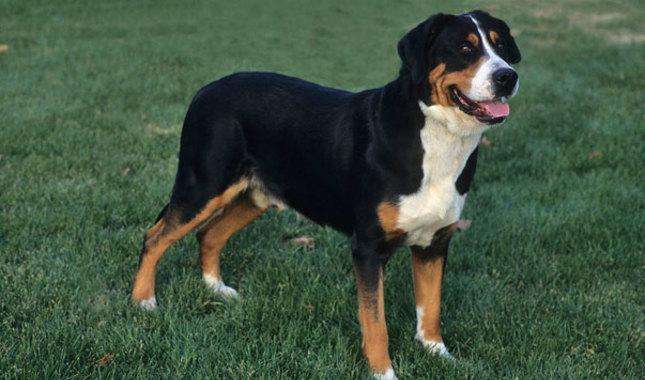Greater Swiss Mountain Dog
IUCN
LCBasic Information
Scientific classification
- name:Greater Swiss Mountain Dog
- Scientific Name:Great Swiss Terrier
- Outline:Carnivora
- Family:Canidae
Vital signs
- length:59.7-72.4cm
- Weight:59-61kg
- lifetime:10-13year
Feature
The largest of the four Swiss Mountain Dog breeds
Distribution and Habitat
Originated from Switzerland
Appearance
The head is strong, the muzzle is thick and short relative to the skull, and the eyes are a variety of colors from light brown to brown. The eyes are deep and gentle, full of wisdom and love. There are symmetrical brown spots above the eyes. The nose is black. The ears are triangular, small and drooping. The neck is strong and short, the chest is very broad, the back is strong and strong, and the topline is straight. The lower abdomen is slightly raised, but not too obvious. The forelimbs are strong and straight; the hindlimbs are strong and strong. The feet are medium-sized, short and round. The tail is always drooping and does not curl upward.
The outer layer of hair is rough, smooth and smooth, not more than 5 cm long, and there is a thick inner layer of hair. The color of the coat is mainly black and tan, and the tan area is bordered by black or white spots. There is a white stripe around the head from the forehead to the nose, and some of the white extends to the chest, toes, t
Details
The Greater Swiss Mountain Dog is a working dog. This native Swiss dog is one of the earliest descendants of the large bullmastiff, which the ancient Romans brought to the Alps.

The Greater Swiss Mountain Dog is a breed designed by people. It is a conspicuous, tri-colored, large, powerful, and determined dog. It is the largest of the four Swiss Mountain Dogs, with smooth, flowing hair and a long tail that always trails behind. The Greater Swiss Mountain Dog is the oldest and largest of the four Swiss dog breeds, including the Bernese Mountain Dog. It is commonly known as the "Grosser Schweizer Sennenhund" in Europe. It is said that the ancestors of the Swiss Dog were brought by the Romans in the 1st century BC. In Switzerland, the Bernard is very popular, but the Greater Swiss Mountain Dog was once thought to be extinct. In 1908, the Greater Swiss Mountain Dog was introduced to the famous cynologist Albert Heirn, who called on dog breeders to save this ancient Alpine dog breed, and then bred it, and finally successfully increased its population. Albert Heim also introduced some other dog breeds to Switzerland. In 1910, the Swiss Kennel Club registered the Greater Swiss Mountain Dog. In 1939, the dog was recognized by the FCI. In 1968, the American Greater Swiss Mountain Dog Club was established to strive for the American Kennel Club to recognize the Greater Swiss Mountain Dog. On March 17, 1993, the American Greater Swiss Mountain Dog Club handed over 1,300 Greater Swiss Mountain Dogs to the American Kennel Club. On April 1, 1995, the American Kennel Club officially accepted the Greater Swiss Mountain Dog as a working dog.
It is said that this dog is also related to the birth and improvement of the Bernese Mountain Saint Bernard. Like the short-haired variety of the Bernese Mountain Dog, the Greater Swiss Mountain Dog's coat is also a bright tri-color short-haired coat.
Apart from the Saint Bernard, this dog may be the largest Swiss Mountain Dog, and it may also be the oldest. For centuries, they have been common traction dogs in villages or farms. In the early 20th century, thanks to the efforts of Franz Schertenlieb and Albert Heim, the Greater Swiss Mountain Dog family was revitalized and their numbers have basically stabilized. The Greater Swiss Mountain Dog is very docile to people, but sometimes it has trouble with other dogs.
The Greater Swiss Mountain Dog is a brave, reliable, responsive working dog, alert and vigilant. It is energetic and tireless, can maintain high energy both day and night, and has good jumping ability. The dog is quiet and easy to train, and can also be used as a companion dog, but because it needs a large activity area, it is not suitable for city residents to keep.
Protect wild animals and stop eating game.
Maintaining ecological balance is everyone's responsibility!








